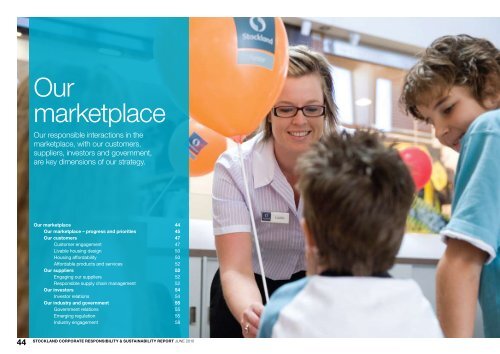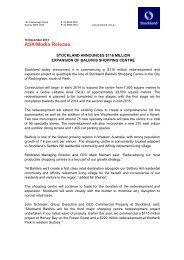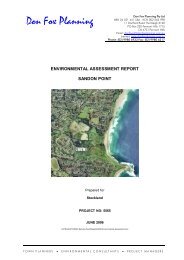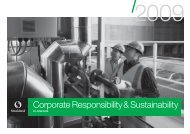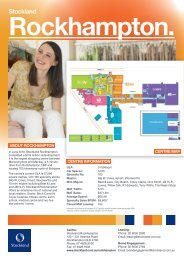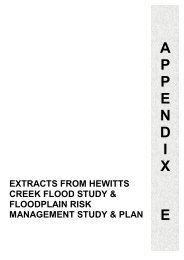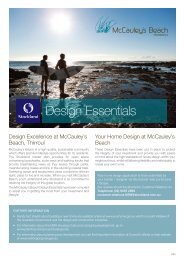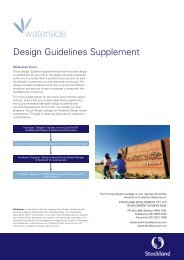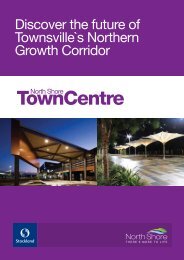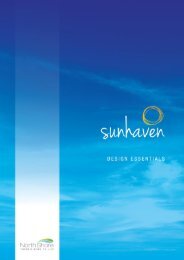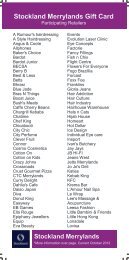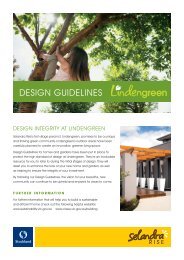Download our marketplace section (pdf) - Stockland
Download our marketplace section (pdf) - Stockland
Download our marketplace section (pdf) - Stockland
You also want an ePaper? Increase the reach of your titles
YUMPU automatically turns print PDFs into web optimized ePapers that Google loves.
Our<br />
<strong>marketplace</strong><br />
Our responsible interactions in the<br />
<strong>marketplace</strong>, with <strong>our</strong> customers,<br />
suppliers, investors and government,<br />
are key dimensions of <strong>our</strong> strategy.<br />
Our <strong>marketplace</strong> 44<br />
Our <strong>marketplace</strong> – progress and priorities 45<br />
Our customers 47<br />
customer engagement 47<br />
livable housing design 50<br />
housing affordability 50<br />
affordable products and services 52<br />
Our suppliers 52<br />
engaging <strong>our</strong> suppliers 52<br />
Responsible supply chain management 52<br />
Our investors 54<br />
Investor relations 54<br />
Our industry and government 55<br />
Government relations 55<br />
emerging regulation 55<br />
industry engagement 58<br />
44<br />
<strong>Stockland</strong> Corporate Responsibility & Sustainability Report June 2010
Our <strong>marketplace</strong> – progress and priorities<br />
Past<br />
Last year, we said we would:<br />
Present<br />
This past year, we have:<br />
Results<br />
Future<br />
In the coming year, <strong>our</strong> priorities are to:<br />
Our customers<br />
Improve understanding of <strong>our</strong> business<br />
customers’ experiences of <strong>our</strong> organisation.<br />
Implement <strong>our</strong> diversity strategy, and<br />
specifically improve access for people<br />
with disabilities to <strong>our</strong> property assets.<br />
Our suppliers<br />
Enhanced housing affordability by:<br />
• Developing an Affordability Benchmarking Tool,<br />
• Developing a ‘product to market’ matching process,<br />
• Enhancing product innovation,<br />
• Influencing external factors affecting affordability.<br />
FY10<br />
Achievement<br />
Achieved a significant improvement in <strong>our</strong> understanding of <strong>our</strong>:<br />
• Retirement Living tenants’ level of happiness, and<br />
• Residential customers’ level of satisfaction. Achieved<br />
outcome<br />
Completed an accessibility checklist for all Commercial<br />
Property assets.<br />
Participated in the development of the National Dialogue on<br />
Universal Housing Design’s Strategic Plan and Livable Housing<br />
Design Guidelines.<br />
Ongoing<br />
> Develop an organisation-wide methodology to examine <strong>our</strong> contribution<br />
to local employment.<br />
> Engage with government on the benefits of creating smaller and more<br />
affordable housing lots.<br />
> Establish targets for lower-cost housing (relative to the local area) in<br />
each of <strong>our</strong> residential communities.<br />
> Continue to pilot and replicate innovative low-cost housing product with<br />
<strong>our</strong> partner builders.<br />
> Continue to improve <strong>our</strong> customer understanding, satisfaction, retention<br />
and performance particularly through ongoing and wider surveying<br />
of customers.<br />
> Commence retrofitting to improve access for people with disabilities,<br />
starting with high priority sites.<br />
> Design and build all new retirement living dwellings to meet the National<br />
Dialogue on Universal Housing Design’s Strategic Plan’s ‘silver standard’<br />
in FY11, and 25% of <strong>our</strong> new residential community homes are to meet<br />
the ‘silver standard’ by 2013.<br />
Improve the frequency and quality of<br />
Health, Safety and Environment (HSE)<br />
communications with contractors and<br />
maintain an effective audit program.<br />
Continue to improve the quality of <strong>our</strong><br />
contractors’ reporting and monitor their<br />
response to incidents and non-compliances.<br />
Complete the implementation of the<br />
contractor induction program in the<br />
Commercial Property business and<br />
trial it in <strong>our</strong> Residential business.<br />
Develop a new IRIS (Incident Reporting<br />
and Investigation System) module for risk<br />
management which will include registers of<br />
pre-qualified auditors and audit results and<br />
action plans.<br />
Conducted HSE component for primary contractor induction,<br />
including formal handover to project manager. Incorporated and<br />
highlighted Indigenous and environmental issues for projects.<br />
Attended construction meetings, development meetings and<br />
primary contractor inductions.<br />
Established contacts to improve ability of contractors to contact<br />
appropriate <strong>Stockland</strong> HSE support personnel.<br />
Continued to develop changes to online contractor induction<br />
program in readiness for roll out to <strong>our</strong> Residential business.<br />
Tested a new IRIS module for audits.<br />
Improved functionality of IRIS modules.<br />
Achieved<br />
outcome<br />
Ongoing<br />
> Conduct HSE development forums with senior contractor and<br />
HSE personnel.<br />
> Review mechanisms for evaluating contractor HSE performance and<br />
audit results.<br />
> Roll out online contractor induction program to <strong>our</strong> Residential business.<br />
> Release the module and develop training and guidance on its use.<br />
> Evaluate the feasibility of developing a Contractor Module for IRIS.<br />
Improve the functionality of IRIS by developing and releasing IRIS<br />
reports based on business needs.<br />
> Continue to refine and expand <strong>our</strong> responsible supply chain<br />
management policies and practices, including:<br />
• embedding expectations in <strong>our</strong> contracts,<br />
• engaging with <strong>our</strong> suppliers to raise <strong>our</strong> combined performance,<br />
• improving how we measure and report <strong>our</strong> suppliers’ performance.<br />
<strong>Stockland</strong> Corporate Responsibility & Sustainability Report June 2010<br />
45
Our <strong>marketplace</strong> – progress and priorities (continued)<br />
Past<br />
Last year, we said we would:<br />
Present<br />
This past year, we have:<br />
Results<br />
Future<br />
In the coming year, <strong>our</strong> priorities are to:<br />
Review and revise <strong>our</strong> approach to Sustainable<br />
Supply Chain Management, focusing on civil<br />
contractors, product suppliers, utilities and<br />
facility management services.<br />
Commenced development of a Group Procurement Strategy<br />
to reinforce <strong>our</strong> commitment to a responsible supply chain.<br />
Continued to engage with suppliers, making clear <strong>our</strong> expectations<br />
of social and environmental sustainability in their offering of services<br />
and products.<br />
Ongoing<br />
Our investors<br />
Enhanced access to online investor information and enc<strong>our</strong>aged<br />
investors to receive electronic communications and ask questions<br />
via <strong>our</strong> website.<br />
FY10<br />
Achievement<br />
> Revise <strong>our</strong> investor communications strategy at least every three years<br />
to capture the preferences of <strong>our</strong> ‘typical’ shareholder demographics.<br />
Our industry and government<br />
Continue to advocate and participate in<br />
market-based mechanisms designed to<br />
enc<strong>our</strong>age and reward energy efficiency.<br />
Contributed to the development of the NABERS Retail tool and<br />
trained relevant employees in applying this tool.<br />
Sponsored and participated in the development of the Green Star<br />
Community Framework.<br />
Ongoing<br />
> Continue to contribute to the discussions and development of marketbased<br />
mechanisms that enc<strong>our</strong>age low carbon, sustainable property.<br />
> Participate in developing the Green Building Council of Australia’s<br />
Green Star Community Rating Tool.<br />
46<br />
<strong>Stockland</strong> Corporate Responsibility & Sustainability Report June 2010
Our <strong>marketplace</strong> comprises <strong>our</strong><br />
relationships with those stakeholders<br />
we do business with and the governance<br />
of this environment. Our <strong>marketplace</strong><br />
is defined by <strong>our</strong> value chain – those<br />
customers we sell products and services<br />
to, <strong>our</strong> suppliers who sell products<br />
and services to us, and <strong>our</strong> investors<br />
who provide capital. Our <strong>marketplace</strong><br />
environment is regulated by government.<br />
Our responsible interactions in the<br />
<strong>marketplace</strong> with <strong>our</strong> customers, suppliers,<br />
investors and government include:<br />
• Improving <strong>our</strong> understanding of<br />
the needs of <strong>our</strong> customers,<br />
• Setting clear performance<br />
expectations with <strong>our</strong> new and<br />
existing suppliers,<br />
• Responding to the issue of<br />
housing affordability,<br />
• Engaging with government to<br />
inform policy development and<br />
attain project approvals.<br />
Our customers<br />
Customer engagement<br />
Residential customer engagement<br />
To help understand <strong>our</strong> Residential<br />
customers’ needs, we use tracking<br />
research called <strong>Stockland</strong> Customer<br />
Pulse. The research, which is conducted<br />
by a third party, covers more than<br />
30 <strong>Stockland</strong> residential communities.<br />
Weekly interviews are conducted by<br />
telephone. In FY10 the number of<br />
interviews conducted with sales leads<br />
and those customers who placed<br />
a deposit totalled more than 4,800.<br />
The survey data is integrated with internal<br />
information to paint a picture of <strong>our</strong> likely<br />
customer mix. Over the c<strong>our</strong>se of FY10,<br />
upgraders (those who have purchased<br />
a property before) represented a larger<br />
proportion of <strong>our</strong> customers compared<br />
to FY09, and we expect this to be the<br />
case for the near future. Consequently,<br />
<strong>our</strong> next residential communities<br />
advertising campaign will focus primarily<br />
on this segment.<br />
The plans for each home that will be<br />
built in <strong>our</strong> communities are required to<br />
undergo a covenant approval process. In<br />
addition to approving suitable homes, this<br />
process enables us to collect data about<br />
homes being built in <strong>our</strong> communities, and<br />
helps us understand what is important to<br />
<strong>our</strong> different customer groups.<br />
To meet the needs of today’s customers<br />
we have introduced an online system<br />
which provides information on what<br />
customers are requesting, and actually<br />
buying. The system also collects<br />
information on environmental ratings<br />
and changing product demands which<br />
provides us with more information about<br />
customers’ sustainability preferences.<br />
The system has increased efficiency in<br />
the design approval process and allows<br />
us to work more closely with <strong>our</strong> builder<br />
partners to ensure we are delivering<br />
tailored product solutions that are meeting<br />
<strong>our</strong> customers’ needs.<br />
Retirement Living residents<br />
Our annual Residents’ Voice Survey<br />
provides residents at <strong>our</strong> retirement<br />
villages with an opportunity to tell us how<br />
they feel about life in a <strong>Stockland</strong> village.<br />
Results of the survey show that <strong>our</strong> village<br />
residents have a high level of satisfaction:<br />
• 91 per cent are happy with their<br />
community centres,<br />
• 75 per cent feel their quality of life<br />
has improved since moving into<br />
their village,<br />
• 37 per cent wish they had<br />
moved sooner.<br />
We use the results of this survey<br />
to analyse customer satisfaction,<br />
identify issues, calculate the best<br />
response and then take action –<br />
while ensuring residents are kept<br />
fully informed.<br />
What is <strong>our</strong> Residents’ Voice survey?<br />
Introduced in 2008, the Residents’<br />
Voice survey asks residents to rate their<br />
happiness from 1 to 10 on aspects such<br />
as overall happiness with the village<br />
to the Village Manager, Senior Nurse,<br />
social activities and outdoor area. The<br />
second survey was sent to approximately<br />
3,300 customers in October 2009 and<br />
achieved a 69 per cent response rate.<br />
How are the results used?<br />
The survey helped us identify what makes<br />
<strong>our</strong> residents happy and also gives us<br />
greater understanding of <strong>our</strong> residents’<br />
interests and the facilities they use.<br />
The results are collated on an overall,<br />
state-by-state and individual village basis<br />
which allows us to measure trends and<br />
to identify areas that have improved and<br />
issues of concern. We are also able to<br />
identify specific village-level issues which<br />
can then be addressed.<br />
Looking ahead<br />
Armed with a deep understanding<br />
of <strong>our</strong> residents’ profiles and needs,<br />
we are able to examine how best to<br />
increase residents’ happiness in the<br />
future. The findings make clear the<br />
benefits of maintaining and improving<br />
residents’ happiness. The FY10 survey<br />
told us 57 per cent had recommended<br />
a <strong>Stockland</strong> village to at least one other<br />
person in the preceding year. Of those<br />
making recommendations, 96 per cent<br />
rated their happiness with the village<br />
overall as 7 out of 10 or higher. The<br />
happier <strong>our</strong> customers, the more likely<br />
they are to recommend new customers.<br />
In FY11 we will continue to focus on<br />
the capabilities of <strong>our</strong> people and<br />
the wellbeing of <strong>our</strong> residents. Village<br />
Managers and Nurses are key drivers<br />
to resident happiness. We will review<br />
objectives for Village Co-ordination<br />
Managers, Village Managers and Nurses,<br />
strengthening <strong>our</strong> focus on residents’<br />
wellbeing. We will support this with a<br />
Wellness Program designed to increase<br />
social activities at each village.<br />
<strong>Stockland</strong> Corporate Responsibility & Sustainability Report June 2010<br />
47
CASE STUDY<br />
Village Residents’ Voice survey<br />
Commercial Property customers<br />
As a diversified property company, we have<br />
a variety of customers. Major customers<br />
such as supermarket chains and discount<br />
department stores are anchor tenants<br />
in <strong>our</strong> retail shopping centres and help<br />
attract national retail specialty chains<br />
and independent retailers. Creating the<br />
right retail mix and environment delivers<br />
a positive shopping experience, ensuring<br />
repeat visits from shoppers.<br />
Our office and industrial customers<br />
comprise a diverse range of tenants:<br />
government departments, blue chip<br />
corporations and small to mediumsized<br />
enterprises. Government tenants<br />
Gowanbrae Village, We conduct research in each of <strong>our</strong><br />
Our previous Residents’ Voice survey told<br />
Vic<br />
business units to obtain feedback from us that some residents were unhappy with are increasingly looking to take space<br />
<strong>our</strong> customers. For Retirement Living, <strong>our</strong><br />
annual Residents’ Voice survey showed that<br />
levels of happiness remained consistently<br />
high in FY10 compared to FY09. This high<br />
level of satisfaction is illustrated by some<br />
of the residents’ quotes:<br />
their Village Manager. Nationally, 8 per<br />
cent rated their happiness as 4 or less<br />
out of 10. No other aspect of village life<br />
received a higher level of dissatisfaction.<br />
In Queensland, this was starker still, with<br />
21 per cent expressing unhappiness.<br />
in buildings where there is evidence of<br />
a commitment to sustainability, while<br />
business customers need great city centre<br />
locations and industrial customers want<br />
cost-effective locations close to transport.<br />
“The bottom line is, I’m very happy. Another To address this, we took these steps:<br />
Getting closer to <strong>our</strong> customers<br />
resident from the village only said to me • Village Managers attended training<br />
With customers firmly at the centre of <strong>our</strong><br />
last week, if she had known how wonderful programs to increase skills, including approach to business, we have ensured<br />
this lifestyle was, she would have made<br />
sales and customer relations,<br />
we have the most up-to-date information<br />
the move five years earlier.” Susan Manley,<br />
on <strong>our</strong> top customers through the creation<br />
• Some responsibilities were centralised<br />
Templestowe Village<br />
of the Top 50 Key Customer Profiles of<br />
within <strong>our</strong> organisation to enable<br />
“Since living at Gowanbrae we’ve both<br />
<strong>our</strong> Commercial Property tenants.<br />
Village Managers to focus more<br />
noticed how much more relaxed we are,<br />
on resident relations,<br />
These profiles provide an overview of<br />
despite being busier than ever. There’s • Several new Village Managers<br />
the customers’ business and strategic<br />
no such thing as a typical day around<br />
were employed,<br />
direction, their Senior Executives, financial<br />
here! To anyone considering a move to a<br />
• The number of Village Coordination<br />
statistics and current opportunities related<br />
retirement village, we couldn’t recommend<br />
Manager roles was increased to<br />
to the <strong>Stockland</strong> portfolio. The profiles<br />
it more.” Joan and Derek Chamberlain,<br />
support Village Managers better.<br />
have been posted on a team site so they<br />
Gowanbrae Village<br />
are widely available and can be updated<br />
In FY10, the percentage of residents who<br />
regularly. These profiles will form the basis<br />
The role of <strong>our</strong> Village Managers gave scores of 1 to 4 in relation to their Village<br />
of a Customer Relationship Management<br />
and residents’ happiness<br />
Manager had halved nationally to 4 per cent.<br />
project due to be implemented in FY11.<br />
Over the past year we focused on the In Queensland, the improvement was<br />
role of <strong>our</strong> Village Managers, who are dramatic: down from 21 to 2 per cent with<br />
responsible for the day-to-day operations a concurrent increase in residents scoring<br />
of <strong>our</strong> villages.<br />
a maximum 10 from 24 to 35 per cent.<br />
To deepen <strong>our</strong> understanding of what is<br />
important to <strong>our</strong> customers, we undertook<br />
research to examine how we can exceed<br />
customer service expectations. We<br />
conducted detailed interviews with Senior<br />
Executives from <strong>our</strong> major retailers and<br />
national specialty chains, and we also held<br />
a number of focus groups with retailers.<br />
The aim of the research is to understand<br />
the ‘drivers of choice’ when retailers decide<br />
on potential store locations. The research<br />
also provides a benchmark to monitor<br />
customer satisfaction. The final results<br />
will help us develop customer-focused<br />
initiatives, which will be delivered in FY11.<br />
In the past year we have also improved the<br />
<strong>Stockland</strong> Service Centre to provide better<br />
service to <strong>our</strong> office tenants. Following an<br />
initial review in FY09, we identified additional<br />
areas for process improvement. This work,<br />
which engaged internal stakeholders<br />
including <strong>our</strong> Facilities Management,<br />
Group Risk, Group Procurement and<br />
Business Process teams, has streamlined<br />
processes to create clear accountabilities<br />
and key performance indicators for the<br />
<strong>Stockland</strong> Service Centre team. This has<br />
led to improved invoice management,<br />
better relationships with <strong>our</strong> suppliers<br />
and greater efficiency in the centre.<br />
Rating customer experience in <strong>our</strong><br />
shopping centres<br />
Our focus on customer experience at<br />
<strong>our</strong> shopping centres has yielded positive<br />
results. Our Mystery Shopper program<br />
has continued to monitor performance<br />
in the core areas of customer interaction,<br />
centre facilities, common areas and<br />
casual leasing during FY10. The scores<br />
show a 7.2 per cent increase in customer<br />
satisfaction with <strong>our</strong> retail centres. We<br />
also outperformed <strong>our</strong> competitors on<br />
the same measures by 7.2 per cent.
CASE STUDY<br />
CSR 5 Star Green Star interior<br />
Triniti, NSW<br />
Our Triniti Campus is a showcase asset<br />
which promotes the merits of green<br />
buildings to the wider community.<br />
Located in the North Ryde area in<br />
New South Wales, <strong>our</strong> Triniti Business<br />
Campus is a 28,000 m² A-grade office<br />
campus, made up of three separate<br />
buildings (I, II and III). The campus<br />
incorporates leading environmental qualities<br />
and won the Property Council of Australia’s<br />
Business Industrial Park Innovation Award<br />
in 2010. Triniti has already achieved a<br />
5 Star Green Star Office As Built v2 rating<br />
for its campus Buildings I and II, and<br />
Building III is registered for a Green Star<br />
As Built submission.<br />
When diversified manufacturing group<br />
CSR Limited moved into Triniti Building III<br />
in January 2010, it was keen to reflect the<br />
sustainability features of the buildings and<br />
demonstrate the company’s commitment to<br />
sustainability through its office fitout. CSR’s<br />
property leaders engaged <strong>our</strong> Commercial<br />
Property sustainability team to help them<br />
achieve this goal.<br />
The CSR project team was determined<br />
to showcase their building products<br />
throughout their fitout including Viridian<br />
Glass, Bradford Insulation, Gyprock<br />
Plasterboard, Cemintel Fibre Cement,<br />
Fricker Ceiling Systems, Hebel Aerated<br />
Concrete, and Rockcore and Alturi<br />
Panel Systems.<br />
To help CSR achieve a Green Star rating<br />
for its tenancy, we provided support and<br />
documentation for its rating submission.<br />
The CSR Triniti Project became the first<br />
project ever to achieve a 5 Star Green<br />
Star – Office Interiors v1.1 rating in a first<br />
round application.<br />
This project illustrates what is<br />
possible when we work together<br />
with <strong>our</strong> customers.<br />
CSR has also signed a green lease with<br />
us, which requires both parties to consider<br />
long-term sustainability commitments.<br />
For CSR, the move to more sustainable<br />
headquarters “welcomed in a new phase<br />
of <strong>our</strong> long history that will enable better<br />
business performance and contribute<br />
further to environmental and community<br />
sustainability,” said Andrew MacKenzie,<br />
General Manager, Property at CSR.<br />
The CSR example is part of <strong>our</strong> broader<br />
commitment to working with customers.<br />
Other initiatives include <strong>our</strong> green lease<br />
project. Currently 31 per cent of <strong>our</strong> office<br />
leases across <strong>our</strong> portfolio are green<br />
leases and we plan to increase this to over<br />
40 per cent in FY11. In retail centres, green<br />
lease clauses are standard for specialty<br />
tenants and have been included in over<br />
700 leases since January 2009. In FY11<br />
we are developing standard green lease<br />
clauses for <strong>our</strong> industrial sites, and will start<br />
to report on the implementation of these<br />
lease clauses in <strong>our</strong> next CR&S report.<br />
<strong>Stockland</strong> Corporate Responsibility & Sustainability Report June 2010<br />
49
CR&S 2010<br />
Our<br />
<strong>marketplace</strong><br />
We have placed stand-alone Customer<br />
Feedback Units in all of <strong>our</strong> centres to<br />
gain first-hand feedback on the parents<br />
room, food c<strong>our</strong>t and customers’<br />
overall experience. Over 60 per cent<br />
of <strong>our</strong> shoppers indicated they would<br />
recommend <strong>our</strong> centre to associates –<br />
a slight decrease on <strong>our</strong> previous year’s<br />
result of 65 per cent. Our positive results<br />
reflect the work done on initiatives,<br />
such as upgraded parents rooms, are<br />
having on <strong>our</strong> customers’ experience.<br />
To ensure superior service across <strong>our</strong><br />
key customer touchpoints (Customer<br />
Care staff in <strong>our</strong> centres and Service<br />
Centre representatives in <strong>our</strong> call<br />
centre), we have undertaken customer<br />
service training in conjunction with the<br />
Customer Service Institute of Australia<br />
(CSIA). To date 36 frontline Customer<br />
Service team members have completed<br />
or are in the final stages of completing a<br />
Certificate IV in Customer Service. Our<br />
aim is to ensure continuous improvement<br />
in customer service standards across<br />
all <strong>our</strong> retail assets.<br />
We have also received feedback from<br />
customers that contractors, cleaning, and<br />
security managers are seen as key points<br />
of contact and have an impact on <strong>our</strong><br />
customers’ experience in centres. As part<br />
of <strong>our</strong> commitment to customer service,<br />
we have created training modules to help<br />
these teams maintain high standards<br />
of customer service. The first of these<br />
modules will be introduced in July 2010<br />
and will be facilitated by <strong>our</strong> centre<br />
Marketing Managers.<br />
Livable housing design<br />
During FY10 we participated in the<br />
development of the National Dialogue on<br />
Universal Housing Design’s Strategic Plan<br />
and Livable Housing Design Guidelines.<br />
Other participants included industry<br />
groups, government agencies and other<br />
property groups.<br />
Livable housing design means designing<br />
homes to meet the changing needs<br />
of occupants across their lifetime. The<br />
guidelines set out key easy living features<br />
that aim to make homes easier and safer<br />
to use for all occupants including: people<br />
with a disability, ageing Australians,<br />
people with temporary injuries and families<br />
with young children.<br />
Over the next year we will develop and<br />
roll out livable housing design guidelines<br />
across <strong>our</strong> organisation. We are<br />
committed to meeting the voluntary target<br />
set out in the Strategic Plan, whereby<br />
all new retirement living dwellings are to<br />
be designed and built to meet the ‘silver<br />
standard’ in FY11, and 25% of <strong>our</strong> new<br />
residential community homes are to<br />
meet the ‘silver standard’ by 2013. The<br />
‘silver standard’ includes features such<br />
as reinforced bathroom walls, a flat entry<br />
to the house and wide corridors and<br />
doorways.<br />
Housing Affordability<br />
A lack of affordable housing is one of<br />
the biggest challenges facing Australians<br />
today. The current undersupply of houses<br />
in Australia of approximately 200,000<br />
is expected to continue, given that<br />
population growth has been well above<br />
the number of homes being built since<br />
2006. This will continue to place pressure<br />
on house prices over time.<br />
The national benchmark that is most<br />
frequently used to assess housing<br />
affordability is the percentage of<br />
disposable income that goes towards<br />
mortgage repayments. When this is more<br />
than 35 per cent, housing is considered<br />
to be ‘unaffordable’. The Australian<br />
average is close to this now.<br />
As Australia’s largest residential developer,<br />
delivering affordable housing is important<br />
to us. Masterplanned communities can<br />
offer product and price flexibility not<br />
available in the established market because<br />
of the variety of prices in the different<br />
product offerings. Our projects are<br />
generally more affordable than the local<br />
median house price within the established<br />
market in the local area (based on <strong>our</strong><br />
analysis of a sub-set of projects).<br />
We focused on f<strong>our</strong> initiatives to improve<br />
housing affordability in FY10.<br />
Affordability Benchmark Tool<br />
We believe that affordability benchmarking<br />
is most meaningful and accurate when<br />
conducted at the local rather than national<br />
level. We have developed the Affordability<br />
Benchmark Tool to assess the financial<br />
capacity of discreet buyer segments<br />
within <strong>our</strong> local catchments. This helps<br />
us to understand what each buyer type<br />
can afford.<br />
‘Product to market’ matching<br />
process<br />
As part of <strong>our</strong> six-monthly business<br />
planning, we use the Affordability<br />
Benchmark Tool, along with other inputs, to<br />
determine whether each project is meeting<br />
market expectations for product and price.<br />
Affordable house and land<br />
product innovation<br />
We are working on reducing the price<br />
of entry level house and land packages.<br />
An example of this is <strong>our</strong> Waterside Town<br />
Houses in New South Wales.<br />
Waterside is a project located at the edge<br />
of the Penrith Lakes District that includes<br />
584 lots, 34 per cent of which has already<br />
been sold. The current price range for land<br />
alone is $199,000–$280,000 which means<br />
that entry-level house and land packages<br />
start at $400,000. To significantly reduce<br />
the entry price at Waterside we are<br />
developing 100 attached, mainly twobedroom<br />
Town Houses. The houses<br />
will have a starting price of $290,000.<br />
We have also reduced the average lot<br />
size to improve affordability. This year<br />
24 per cent of <strong>our</strong> lots were under 400m 2<br />
whereas only 16 per cent of lots were<br />
below this size last year.<br />
50<br />
<strong>Stockland</strong> Corporate Responsibility & Sustainability Report June 2010
CASE STUDY<br />
Housing affordability<br />
External factors contributing<br />
to a lack of housing affordability<br />
There are a number of other factors that<br />
are contributing to the lack of affordable<br />
housing, such as the inconsistency of<br />
developer infrastructure contribution<br />
charging. Improving the consistency of<br />
these contributions would reduce costs<br />
and as such, lead to reduced consumer<br />
prices. We therefore engage with industry<br />
bodies and speak at public forums<br />
on issues such as these to influence<br />
housing affordability.<br />
FY11 activities<br />
In FY11 we plan to further improve the<br />
affordability of <strong>our</strong> communities relative<br />
to the local established market in areas<br />
where we operate. In addition to the<br />
initiatives above, we will also:<br />
• Target specific proportions of land<br />
developed in each community<br />
as ‘affordable stock’ (likely to be<br />
10–20 per cent of stock capable<br />
of being met by the budgets of first<br />
home buyers within the relevant<br />
catchment area).<br />
• Work with local authorities,<br />
government and industry to transform<br />
planning which constrains small lot<br />
affordable housing development.<br />
Highlands, Vic<br />
Affordable housing at Highlands<br />
residential community<br />
Federal and state government housing<br />
stimulus measures in late 2009 were<br />
responsible for driving strong first home<br />
buyer demand. This led us to consider<br />
two questions:<br />
• How do we continue to provide housing<br />
that is affordable to this group in the<br />
face of rising prices?<br />
• How do we continue to service the<br />
demands of this market segment once<br />
stimulus measures have been removed?<br />
To help address these issues, we<br />
launched an initiative to develop<br />
packaged house and land solutions<br />
for under $300,000 at <strong>our</strong> Highlands<br />
residential community in<br />
Melb<strong>our</strong>ne’s North.<br />
Highlands is a carefully-planned community<br />
designed for families, with parklands<br />
and open space and is close to schools<br />
and amenities.<br />
Targeting the under $300,000 price point<br />
requires innovation. Analysis suggested<br />
that a $300,000 package would involve a<br />
land component of $120,000. At Highlands,<br />
no standard lots were capable of meeting<br />
this price point, with a lot size of 212.5m 2<br />
representing the budget threshold.<br />
To make new home buying easier for those<br />
starting out, we worked with builders<br />
Henley Properties Group to develop<br />
a range of affordable fixed price house<br />
and land packages:<br />
• Land produced at a standard<br />
8.5m x 25m lot configuration.<br />
• An initial five lots released to the market,<br />
with scope to release another 34 lots<br />
over the c<strong>our</strong>se of FY10.<br />
• Customised small lot house designs<br />
developed and built by Henley.<br />
The product has been highly successful.<br />
At 30 June we had achieved a total of 20 lot<br />
sales of these lot packages and plans are<br />
now underway to incorporate this approach<br />
in other Victorian communities, with similar<br />
initiatives being planned for the other states.<br />
In total, approximately 110 additional lots<br />
are planned for development in FY11, with<br />
a further three builders also developing<br />
designs to compete in this market.<br />
Grant allocations in Western Australia<br />
In Western Australia, affordability gains<br />
were achieved by securing over $3 million<br />
from the Federal Government’s Housing<br />
Affordability Fund to accelerate key<br />
infrastructure in two residential communities<br />
at reduced cost, with gains passed on<br />
to purchasers:<br />
• At Newhaven, $1.75 million was received<br />
to help relocate power infrastructure<br />
which traverses the site. The funding<br />
expedited this activity, allowing a further<br />
59 lots to be developed in the Newhaven<br />
Town Centre.<br />
• At Settlers Hills, a $1.5 million grant<br />
was used to construct a new road which<br />
makes access available to a further<br />
50 lots for development in the project.<br />
This funding enabled us to subsidise<br />
development costs by $30,000 per lot<br />
across more than 100 home sites in the<br />
two communities, greatly improving access<br />
to affordable housing in the region.<br />
<strong>Stockland</strong> Corporate Responsibility & Sustainability Report June 2010<br />
51
CR&S 2010<br />
Our<br />
<strong>marketplace</strong><br />
Affordable products<br />
and services<br />
Affordability extends beyond <strong>our</strong><br />
Residential business as we aim to provide<br />
good quality space and good value<br />
services to <strong>our</strong> tenants throughout <strong>our</strong><br />
retail, office and industrial assets.<br />
For many years we have worked with<br />
a variety of external agents, such as<br />
marketing experts, financial planners<br />
and merchandising specialists, to help<br />
<strong>our</strong> tenants facing financial difficulties. In<br />
FY11 we will be partnering with a training<br />
provider to deliver voluntary training to<br />
retail tenants on financial management.<br />
We also provide low cost or free casual<br />
leasing space to not-for-profit and<br />
community groups in <strong>our</strong> retail centres.<br />
This has been extended to occasional<br />
support to tenants such as the not-forprofit<br />
organisation, Sydney Care which,<br />
at no cost, uses office and warehouse<br />
space in <strong>our</strong> facility at North Ryde, Triniti.<br />
We see this as a tangible way to support<br />
community organisations.<br />
To further extend <strong>our</strong> support to tenants<br />
to meet affordability needs, we have<br />
partnered with the New South Wales<br />
Department of Climate Change and<br />
Water to provide retail tenants with energy<br />
efficiency training. This training – delivered<br />
in a dynamic, online format – will help<br />
<strong>our</strong> tenants reduce their energy bills<br />
and improve environmental efficiencies.<br />
We will report on outcomes in <strong>our</strong><br />
CR&S report 2011.<br />
Our suppliers<br />
Engaging <strong>our</strong> suppliers<br />
As a property owner, manager and<br />
developer, we have a large number of<br />
contractors and suppliers. We recognise<br />
that we can have a significant impact by<br />
engaging with them on sustainability. Our<br />
contractors and suppliers include builders<br />
and civil contractors, as well as security<br />
and cleaning service providers. Despite<br />
<strong>our</strong> lack of direct control over these<br />
activities, we can influence the decisions<br />
made by <strong>our</strong> contractors on the selection<br />
of materials and the working conditions<br />
of their employees, by setting clear<br />
expectations. Engaging <strong>our</strong> suppliers is<br />
a key focus area for us and allows us to:<br />
• Manage shared risks in relation to<br />
green tools and regulatory reporting,<br />
• Discover shared innovation<br />
opportunities,<br />
• Work together to enhance <strong>our</strong><br />
relationships with the communities<br />
in which we operate.<br />
In FY10 we began integrating CR&S<br />
requirements, systems and targets<br />
into scope of work documents and<br />
specifications for <strong>our</strong> suppliers.<br />
We have developed sustainability<br />
guidelines in <strong>our</strong> business units to<br />
help suppliers better understand<br />
<strong>our</strong> sustainability goals.<br />
Most suppliers already recognise<br />
that sustainability initiatives and obligations<br />
are part of doing business with us. We are<br />
working with suppliers to support them as<br />
they expand their commitments and face<br />
emerging regulatory requirements and<br />
growing stakeholder expectations.<br />
Sustainability obligations for<br />
<strong>our</strong> suppliers<br />
Our suppliers’ performance, where<br />
possible, is measured against specified<br />
sustainability obligations. These measures<br />
are generally reviewed monthly or as part<br />
of the project completion review. Examples<br />
of <strong>our</strong> sustainability obligations are:<br />
Lab<strong>our</strong> – Obligations are embedded in<br />
the general conditions of contract and are<br />
reviewed regularly to ensure compliance.<br />
They cover issues such as wages,<br />
insurance and payment of benefits.<br />
Health and Safety – Obligations reflect<br />
statutory obligations and are embedded<br />
in the general conditions of contract.<br />
Compliance with these obligations is<br />
monitored as part of asset reviews.<br />
Environmental – Obligations reflect<br />
statutory obligations and are embedded<br />
in the general conditions of contract.<br />
Compliance with these obligations is<br />
monitored as part of asset reviews.<br />
Waste – We have set targets for increasing<br />
the amount of waste that is diverted from<br />
landfill to recycling. For <strong>our</strong> office business<br />
a target of 70 per cent diversion from<br />
landfill forms part of the waste agreement.<br />
Mechanical – Capital expenditure (capex)<br />
projects now specify low emission and<br />
energy-efficient equipment. Where possible<br />
low environmental impact materials are<br />
being used. Testing and balancing new air<br />
conditioning plant and other equipment is<br />
now focused on optimising the building’s<br />
NABERS rating, improving building energy<br />
efficiency and maximising overall plant/<br />
equipment performance.<br />
Lifts – Capex projects specify, where<br />
possible, renewable and environmentallysensitive<br />
material. Systems are also<br />
designed to operate in the most energyefficient<br />
manner.<br />
Security – We are introducing customer<br />
service training for <strong>our</strong> security suppliers.<br />
This will help increase the skills of security<br />
contractors and will lead to improved<br />
service levels and customer interaction.<br />
The lab<strong>our</strong>, health and safety and<br />
environmental measures are core<br />
requirements for all suppliers. The other<br />
measures listed above are selected after<br />
consideration of the scope of the works<br />
and services to be delivered and the<br />
opportunities available.<br />
We are committed to ensuring that<br />
sustainability remains a consideration<br />
for services and construction contracts,<br />
and to further improving <strong>our</strong> responsible<br />
supply chain management initiatives. Over<br />
the past year we have continued to survey<br />
<strong>our</strong> larger suppliers on their corporate<br />
responsibility and sustainability policies,<br />
commitments and performance.<br />
Responsible Supply Chain<br />
Management<br />
Our commitment to responsible supply<br />
chain management is driven by the<br />
following factors:<br />
• Corporate values – aligning<br />
<strong>our</strong> corporate values with <strong>our</strong><br />
procurement practices,<br />
• Legislation – now and emerging,<br />
• Cost reduction – creating<br />
sustainable value,<br />
• Improving efficiencies,<br />
• Market and customer requirements,<br />
• Risk management – including<br />
reputational risk.<br />
52<br />
<strong>Stockland</strong> Corporate Responsibility & Sustainability Report June 2010
In recognition of the need to continually<br />
improve <strong>our</strong> supply chain management<br />
performance we are developing a Group<br />
Procurement strategy, led by <strong>our</strong> Chief<br />
Financial Officer. The strategy will embed<br />
responsible supply chain management<br />
into <strong>our</strong> day-to-day operations and<br />
improve controls, processes and<br />
transparency across <strong>our</strong> supply chain.<br />
This will build on the work that we have<br />
already undertaken.<br />
The benefits of this strategy will<br />
be increased governance, stronger<br />
partnerships with suppliers and<br />
more innovative, efficient and<br />
cost-effective products and services.<br />
We have recruited a General Manager<br />
of Procurement to manage this strategy.<br />
Programs and strategies on responsible<br />
supply chain management now form<br />
part of <strong>our</strong> sustainability policies in <strong>our</strong><br />
Residential, Commercial Property and<br />
Retirement Living businesses. The<br />
policies include social and environmental<br />
expectations in supplier agreements,<br />
where possible, and ensure that the<br />
sustainability aspects of each service<br />
are considered and addressed by the<br />
business. This work will feed into the<br />
Group Procurement strategy.<br />
We will work with major suppliers over<br />
the next 12 months as we continue<br />
to refine <strong>our</strong> responsible supply chain<br />
management policies and practices. This<br />
will involve reviewing current practices,<br />
improving outcomes and aligning <strong>our</strong><br />
approach to responsible supply chain<br />
management with <strong>our</strong> suppliers. Our<br />
goal is to help suppliers develop their<br />
systems and practices over and above<br />
the requirements that are specified.<br />
Safety and performance<br />
Our business partners play an important<br />
role in the overall health and safety<br />
performance of <strong>our</strong> organisation. Our<br />
FY10 Health, Safety and Environment<br />
(HSE) strategy sets out clear actions on<br />
the accountability of health and safety<br />
planning and performance not only for<br />
<strong>our</strong> people, but also for <strong>our</strong> business<br />
partners and suppliers. In FY10 we:<br />
• Refined <strong>our</strong> contract documents to<br />
clarify responsibilities at sites where<br />
we have multiple contractors working,<br />
• Introduced improvements to <strong>our</strong><br />
contractor briefing and induction<br />
processes and established clear<br />
policies for control of tenancy fitout<br />
works carried out by <strong>our</strong> contractors,<br />
• Began developing an online induction<br />
process for contractors in <strong>our</strong><br />
Residential business to build on<br />
the success of the system already<br />
implemented for <strong>our</strong> Commercial<br />
Property contractors.<br />
We continued to share learning from<br />
incident investigations across <strong>our</strong><br />
contractor community by distributing safety<br />
alerts and meeting contractors on site. Our<br />
incident reporting system helped us identify<br />
recurring incidents involving contractors<br />
striking buried and overhead electrical and<br />
gas services and we worked closely with<br />
contractors to improve the processes they<br />
use to manage these hazards.<br />
Understanding <strong>our</strong> and <strong>our</strong><br />
contractors’ HSE responsibilities<br />
At the commencement of a construction<br />
project we appoint a construction<br />
contractor as ‘principal contractor’ for the<br />
purpose of workplace health and safety<br />
legislation. This appointment covers the<br />
whole of the ‘site’ which is handed over<br />
to the construction contractor to carry<br />
out the works. This is also consistent with<br />
individual state legislative requirements.<br />
If we engage a separate contractor<br />
to carry out work on the ‘site’, that<br />
contractor is subject to the control of the<br />
construction contractor as is necessary<br />
for the construction contractor to meet<br />
its ‘principal contractor’ obligations.<br />
We appoint the main construction<br />
contractor as principal contractor and they<br />
are responsible for the site and their own<br />
works as well as the management and<br />
control of access and movements on the<br />
site and in common areas. The tenant,<br />
or the tenant’s fit-out contractor, will then<br />
be principal contractor in the ‘shell’, and<br />
in control of the activities of theirs and/or<br />
the main contractor when working within<br />
that shell. Contracts clearly stipulate that<br />
HSE requirements are to be consistent<br />
with <strong>our</strong> HSE Commitment Statement.<br />
We continue to work closely with <strong>our</strong><br />
Project and Development Managers<br />
to ensure clarity on responsibilities for<br />
contractors. HSE Managers and Advisers<br />
continue to work closely with both<br />
Principal Contractors and Contractors<br />
directly engaged by <strong>Stockland</strong> to ensure<br />
that systems are in place and are being<br />
applied consistently and effectively.<br />
Contractor HSE performance<br />
We do not currently include contractor lost<br />
time injuries and other indicators in <strong>our</strong><br />
HSE reporting. In FY11, we will investigate<br />
how to incorporate this information<br />
into <strong>our</strong> regular reporting frameworks.<br />
This will include assessing the viability<br />
of extending <strong>our</strong> Injury Reporting and<br />
Investigation System (IRIS) database<br />
to include contractors.<br />
HSE survey of contractors<br />
We conducted <strong>our</strong> first comprehensive<br />
HSE survey of contractors this year and<br />
received feedback from more than<br />
60 civil construction contractors.<br />
We learned that, like us, <strong>our</strong> contractors<br />
view health and safety as a collaborative<br />
effort and 97 per cent said that we<br />
have high standards and are clear<br />
about health and safety expectations.<br />
We received positive feedback on <strong>our</strong><br />
collaborative approach and on <strong>our</strong><br />
pre-start briefings, risk assessments and<br />
reporting processes. The contractors also<br />
suggested a number of improvements that<br />
we can make, such as ensuring everyone<br />
observes full compliance to contractors’<br />
site rules and conducting joint site audits<br />
and inspections. We will respond to<br />
these suggestions.<br />
Supporting contractors’<br />
HSE initiatives<br />
During the year, we maintained <strong>our</strong><br />
support of contractors’ safety initiatives,<br />
such as toolbox talks, and ran a program<br />
of events for contractors during Safe Work<br />
Week. The HSE team is also building<br />
relationships with contractors and their<br />
HSE personnel, which is resulting in<br />
more open and timely communication.<br />
We continue to work closely with<br />
contractors to identify and apply<br />
sustainable solutions that, where<br />
possible, reduce environmental impacts.<br />
Reducing slip, trip and fall incidents<br />
at <strong>our</strong> retail centres<br />
We launched a number of initiatives in<br />
FY10 to reduce the number of slip, trip<br />
and fall incidents at <strong>our</strong> retail centres. We<br />
mapped incidents at each property using<br />
<strong>our</strong> improved incident reporting system<br />
and used this to identify and eliminate<br />
common causes.<br />
<strong>Stockland</strong> Corporate Responsibility & Sustainability Report June 2010<br />
53
CASE STUDY<br />
Retail Shareholder research<br />
Our investors<br />
We are committed to effectively<br />
• How should we communicate with <strong>our</strong><br />
54 <strong>Stockland</strong> Corporate Responsibility & Sustainability Report June 2010 communicating with all <strong>our</strong> stakeholders.<br />
retail shareholders?<br />
Our retail shareholders are a key group<br />
– Despite the vast majority having<br />
of stakeholders for whom targeted and<br />
access to the internet, 80 per<br />
effective communication can significantly<br />
cent preferred to receive printed<br />
impact their investment choices.<br />
communications in the mail rather<br />
To better understand if <strong>our</strong> retail<br />
than electronically.<br />
shareholders are satisfied with <strong>our</strong><br />
• Are retail shareholders satisfied with the<br />
communication methods, such as <strong>our</strong><br />
updated corporate reports, particularly<br />
Shareholder Review, we conducted<br />
the Shareholder Review?<br />
research in April 2009.<br />
– 73 per cent of shareholders recalled<br />
The results of the research led to<br />
receiving the Shareholder Review,<br />
improvements to the content and<br />
– 81 per cent of those shareholders<br />
the format of <strong>our</strong> Shareholder<br />
who recall the report read or<br />
Review and website in June 2009.<br />
skimmed the report,<br />
To find out if these changes were well<br />
– 98 per cent of retail shareholders<br />
received we undertook quantitative<br />
rated the Shareholder Review<br />
research in October 2009. Shareholders<br />
positively and it achieved a high<br />
were invited to participate in a 13-minute<br />
overall satisfaction score of<br />
Computer Assisted Telephone Interview. A<br />
7.33 out of 10.<br />
total of 400 interviews were completed and To keep on top of these insights, we will<br />
69 per cent of retail shareholders contacted revise <strong>our</strong> communications strategy at<br />
were willing to participate in the research. least every three years. This will help<br />
The survey findings allowed us to answer us to capture changes to <strong>our</strong> ‘typical’<br />
the following questions:<br />
shareholder demographic and will ensure<br />
•<br />
that <strong>our</strong> communications continue to be<br />
Are retail shareholders satisfied with<br />
useful for <strong>our</strong> target groups.<br />
<strong>Stockland</strong>’s communication?<br />
– Overall satisfaction of retail<br />
shareholders with communications<br />
<strong>Stockland</strong> Shareholder Review 2009<br />
from <strong>Stockland</strong> was high: 7.9 out<br />
of 10,<br />
– 90 per cent of retail shareholders<br />
felt the frequency of <strong>our</strong><br />
communications was appropriate.<br />
Investor relations<br />
We have over 50,000 securityholders in<br />
Australia and overseas. We aim to ensure<br />
that securityholders are kept well-informed<br />
of all major developments and business<br />
events that are likely to materially affect<br />
<strong>our</strong> operations and financial standing and<br />
the market price of <strong>our</strong> securities. A copy<br />
of <strong>our</strong> policy on <strong>our</strong> communication to<br />
securityholders is provided in <strong>our</strong> Annual<br />
Report and is available on <strong>our</strong> website<br />
in accordance with Principle 6 of the<br />
ASX Corporate Governance Principles<br />
and Recommendations.<br />
We provide securityholders with<br />
information through <strong>our</strong> annual and half<br />
year financial reports and announcements<br />
of market-sensitive and other information,<br />
results and analyst presentations. These<br />
documents are lodged with the ASX and<br />
are available electronically on <strong>our</strong> website<br />
at www.stockland.com.au. In addition,<br />
the annual and half year financial report<br />
is made available to all securityholders.<br />
Securityholders are enc<strong>our</strong>aged to<br />
engage with senior management and <strong>our</strong><br />
Board of Directors at <strong>our</strong> Annual General<br />
Meeting. Copies of addresses by the<br />
Chairman and Managing Director and the<br />
minutes of the Annual General Meeting are<br />
also lodged with the ASX and are available<br />
electronically on <strong>our</strong> website.<br />
In addition, we communicate with the<br />
investment community via regular<br />
group and one-on-one management<br />
meetings with institutional investors and<br />
analysts, site visits, presentations by<br />
senior management and by participating<br />
in domestic and offshore investor<br />
conferences and roadshows. Group<br />
briefings are webcast over the internet<br />
and telecast.
Over the past year we have enhanced<br />
access to online investor information and<br />
enc<strong>our</strong>age investors to receive electronic<br />
communications and ask questions via<br />
<strong>our</strong> website. In May 2009, we undertook<br />
qualitative research with some of <strong>our</strong> retail<br />
shareholders to understand attitudes and<br />
preferences for communication channels.<br />
In response to this research, in November<br />
2009, we conducted quantitative<br />
research to validate <strong>our</strong> findings and<br />
highlight the extent to which <strong>our</strong> findings<br />
were representative of <strong>our</strong> overall retail<br />
shareholder base.<br />
Federal energy efficiency programs<br />
Planning<br />
Renewable/<br />
Decentralised<br />
Energy<br />
Innovation<br />
Skills<br />
Federal Government<br />
Energy Efficiency<br />
Programs for the<br />
Built Environment<br />
Appliances<br />
Our industry and government<br />
Government relations<br />
Second only to market conditions,<br />
government regulations have the most<br />
substantial impact on the profitability<br />
of <strong>our</strong> businesses. By necessity we<br />
actively engage with governments, public<br />
servants, regulators and <strong>our</strong> industry<br />
bodies with respect to policy decisions<br />
in general and those that affect <strong>our</strong><br />
many properties. This engagement<br />
is governed by a Board-endorsed<br />
government relations policy that applies<br />
Building<br />
Codes<br />
Government<br />
Procurement<br />
Reporting<br />
Rating Tools<br />
Incentives<br />
and Market<br />
Transformation<br />
to all <strong>our</strong> people and covers donations,<br />
consultants, access to <strong>our</strong> properties,<br />
gifts and personal political participation.<br />
The policy is updated annually and<br />
communicated to <strong>our</strong> people through<br />
<strong>our</strong> Executive Committee.<br />
Stakeholders take great interest in <strong>our</strong><br />
stance on political donations. In July 2008,<br />
as part of <strong>our</strong> annual review, <strong>our</strong> Board<br />
moved from a bi-partisan donations<br />
policy to implement a zero political<br />
donations policy.<br />
We do not make direct or indirect<br />
transfers of money to political<br />
parties or politicians at any level<br />
of government.<br />
In adopting this policy we seek to<br />
emphasise <strong>our</strong> longstanding ethical<br />
principle that <strong>our</strong> projects be judged<br />
solely on their merits.<br />
We actively monitor legislative and<br />
regulatory change directly through <strong>our</strong><br />
businesses and the Corporate Affairs<br />
team, as well as via key industry bodies.<br />
The Property Council of Australia (PCA),<br />
Green Building Council of Australia<br />
(GBCA) and Shopping Centre Council<br />
of Australia are <strong>our</strong> primary representative<br />
bodies at both federal and state levels.<br />
Emerging regulation<br />
Perhaps the most significant policy<br />
deliberation that will inform <strong>our</strong> business<br />
decisions in the coming years is the long<br />
overdue national debate about sustainable<br />
population levels and proper land use<br />
planning. We believe that population<br />
growth and both brownfield and greenfield<br />
development are sustainable in the long<br />
term provided governments engage in<br />
radical infrastructure and planning reform.<br />
We have engaged in this discussion with<br />
every level of government and many other<br />
stakeholders in Australia over the past year.<br />
Reform should include strategic<br />
planning for <strong>our</strong> urban areas in line<br />
with the Development Assessment<br />
Forum principles, and an increase in<br />
infrastructure funded by broad-based<br />
taxes and bond-style investment options.<br />
We support the close involvement of the<br />
current and future Federal Governments<br />
in these processes.<br />
This year there were many state<br />
regulations and policy announcements<br />
that had substantial influences on <strong>our</strong><br />
business. These include regulations<br />
relating to the introduction of planning<br />
panels, land tax valuation changes, koala<br />
preservation, industrial land zoning, bans<br />
on covenants, developer levies, urban<br />
boundary extensions and greater strictures<br />
relating to moth populations. Both in<br />
response to governments’ actions and<br />
proactively, we have made many proposals<br />
and submissions to governments on<br />
matters such as planning, taxation and<br />
environmental regulation.<br />
Also, in early 2010 the Federal<br />
Government announced that it would<br />
defer the development and introduction<br />
of an emissions trading scheme,<br />
referred to as the Carbon Pollution<br />
Reduction Scheme (CPRS). Despite this<br />
announcement, the government continues<br />
to regulate for increasingly robust energy<br />
and greenhouse gas reporting.<br />
<strong>Stockland</strong> Corporate Responsibility & Sustainability Report June 2010<br />
55
CR&S 2010<br />
Our<br />
<strong>marketplace</strong><br />
56<br />
Over the year, and particularly since the<br />
announcement to defer the CPRS, the<br />
government has increased its focus on<br />
energy efficiency as a means to reduce<br />
greenhouse gas emissions. Regulators<br />
recognise that buildings represent a<br />
key opportunity in realising significant<br />
improvements in energy efficiency. As a<br />
consequence, <strong>our</strong> sector has encountered<br />
increasing regulatory requirements. Areas<br />
of strengthening regulation include:<br />
• Emissions and energy efficiency<br />
disclosure – particularly for buildings,<br />
• Adaptation to the physical impacts<br />
of climate change,<br />
• Increasingly stringent building<br />
code requirements.<br />
In general, regulation related to<br />
sustainability performance has become<br />
increasingly complex with different layers<br />
of government seeking to take action.<br />
Through the Property Council of<br />
Australia and the Green Building<br />
Council of Australia we have<br />
advocated for the harmonisation<br />
of reporting and regulatory<br />
requirements.<br />
Over the year, we have also engaged with<br />
government on energy, climate change and<br />
wider environmental policy development.<br />
National Greenhouse and Energy<br />
Reporting System (NGERS)<br />
The National Greenhouse Emissions<br />
Reporting Act (NGERA) is a national<br />
system for reporting greenhouse gas<br />
emissions and energy consumption and<br />
production by corporations. We sought<br />
advice in preparation for <strong>our</strong> first NGERS<br />
report in October 2009, accounting<br />
for emissions in FY09. Our preparation<br />
has included:<br />
<strong>Stockland</strong> Corporate Responsibility & Sustainability Report June 2010<br />
• Improving the quality of <strong>our</strong> emissions<br />
data collection and analysis system,<br />
known as the Climate Change Action<br />
Plan (CCAP) online reporting and<br />
analysis tool,<br />
• Preparing a gap analysis to identify<br />
and then confirm that data sets are<br />
captured by the data system,<br />
• Seeking legal advice on the application<br />
of the NGERA to <strong>Stockland</strong>,<br />
• Engaging with property peers to<br />
develop an ‘Industry View Document’<br />
to assist with the interpretation of<br />
the NGERA, and the implementation<br />
of NGERS reporting for property<br />
organisations and those contracting<br />
to property organisations.<br />
In working towards meeting the<br />
requirements of NGERS, Development<br />
Managers, Facility Managers and<br />
Operations Managers have been<br />
engaged, along with many of their<br />
impacted contractors, to make<br />
them aware of these new reporting<br />
requirements. Responsibility for<br />
greenhouse gas emissions data collection<br />
is being transferred from the sustainability<br />
teams to <strong>our</strong> group and business unit<br />
finance teams to support the level of rig<strong>our</strong><br />
and accuracy required by the NGERA.<br />
Energy Efficiency Opportunities<br />
(EEO) Act, 2006<br />
The EEO Act aims to improve the<br />
identification and evaluation of energy<br />
efficiency opportunities by large energyusing<br />
businesses and enc<strong>our</strong>ages<br />
implementation of cost-effective<br />
opportunities. In 2007, we registered for<br />
EEO participation and set out a reporting<br />
schedule, which was approved by<br />
government in 2008.<br />
We commenced training and identification<br />
of opportunities to implement energy<br />
efficiency initiatives across the retail and<br />
office portfolios and have implemented<br />
some of the identified initiatives.<br />
We submitted <strong>our</strong> first formal report to<br />
government in December 2008 and<br />
reported again in December 2009. Our<br />
EEO report is available on <strong>our</strong> website.<br />
Planning approvals and climate<br />
change assessment<br />
Climate change assessments, particularly<br />
in relation to floodplain risk management,<br />
are increasingly expected as part of the<br />
planning approval process for property<br />
development in Australia. The Victorian<br />
coastal strategy now requires consideration<br />
of sea level rise as part of planning<br />
assessment, proposing a minimum<br />
100 year sea-level rise estimate of 80cm<br />
be applied for planning purposes. The New<br />
South Wales Government has prepared<br />
a draft sea level risk policy statement, and<br />
includes reference to benchmarks of a<br />
rise of 40cm by 2050 and 90cm by 2100<br />
relative to 1990 levels. Similar statements<br />
and policies are being developed by other<br />
state and local governments. The Federal<br />
Government is also exploring policy<br />
related to climate change adaptation,<br />
specifically sea level risk and storm surge.<br />
Building Code of Australia (BCA) –<br />
draft amendments<br />
The BCA has established minimum<br />
requirements for energy efficiency in new<br />
buildings. Specific requirements vary from<br />
state to state. Significant draft changes<br />
to the BCA’s energy efficiency provisions<br />
were announced in June 2009. Changes<br />
to the code include requirements for<br />
increased energy efficiency performance<br />
and requirements for renewable energy.<br />
We have engaged with peers and<br />
industry groups to better understand the<br />
implications of these changes.<br />
State-based residential energy<br />
efficiency requirements<br />
The development of <strong>our</strong> Residential<br />
Communities, Apartments and Retirement<br />
Living businesses is subject to a range<br />
of energy efficiency requirements. These<br />
state-based requirements vary in focus,<br />
leading to different built form outcomes<br />
in different states.<br />
Council of Australian Governments<br />
(COAG) – National Strategy on<br />
Energy Efficiency<br />
The National Strategy on Energy Efficiency<br />
was released by COAG on 2 July 2009.<br />
The strategy addresses a vast range of<br />
topics including: proposed increases in<br />
building code requirements, reporting<br />
legislation, rating tool harmonisation,<br />
green building incentives, government<br />
procurement policies, appliance labelling<br />
regulation, innovation programs,<br />
renewable/decentralised energy<br />
programs and targets, skills programs<br />
and market transformation.<br />
Aspects of the strategy with significant<br />
implications for us include:<br />
• Improving consistency in energyefficiency<br />
standard setting and<br />
performance assessment frameworks,<br />
• Introducing mandatory disclosure<br />
of energy performance in existing<br />
commercial buildings (to be phased<br />
in from October 2010 – see page 58),<br />
now known as Commercial Building<br />
Disclosure (CBD),<br />
• Introducing mandatory disclosure<br />
of eco-efficiency performance of<br />
residential buildings at point of<br />
lease or sale (to be phased in from<br />
May 2011, commencing with energy),<br />
• Increasing energy-efficiency<br />
standards for residential buildings<br />
to 6 Stars nationally (proposed for<br />
implementation by May 2011).
CASE STUDY<br />
Framing energy efficiency tools and policy<br />
As Australia prepares for a lower carbon<br />
future, and grapples with the security of<br />
energy supply to meet the needs of a<br />
growing population, the Council of Australian<br />
Governments (COAG) released a National<br />
Strategy for Energy Efficiency (NSEE) in<br />
July 2009. Since the release of the strategy,<br />
focus on energy efficiency has continued to<br />
grow, particularly in the wake of the deferral<br />
of the Carbon Pollution Reduction Scheme.<br />
We have been responding to the actions<br />
and intentions set out in the NSEE<br />
strategy by informing policy and helping<br />
to shape emerging, related regulation.<br />
We have also provided guidance to peers<br />
on understanding new energy efficiency<br />
and reporting compliance requirements.<br />
In particular, we have engaged with the<br />
Department of Climate Change and Energy<br />
Efficiency (DCCEE) to share <strong>our</strong> experiences<br />
on realising eco-efficiency outcomes.<br />
Distributed Energy National Forum<br />
The NSEE proposed a national forum<br />
on co-generation and tri-generation. We<br />
hosted and participated in this dialogue<br />
in June 2010. Participants agreed to<br />
expand the forum’s remit to address<br />
the challenges and opportunities with<br />
distributed energy. The forum explored<br />
existing barriers, and the work required by<br />
government, industry bodies, the property<br />
sector and the energy sector, to support<br />
widespread implementation of distributed<br />
energy solutions.<br />
We are keen to explore significant distributed<br />
energy solutions – however, we are mindful<br />
of the barriers, particularly regulation and grid<br />
connection. Our tri-generation plant at <strong>our</strong><br />
corporate headquarters, Stockhome, was<br />
<strong>our</strong> first experience in local energy generation.<br />
The next step is to realise greater<br />
efficiencies across a group of<br />
buildings and we recognise that<br />
distributed energy supply will be<br />
key in developing future precincts<br />
and communities.<br />
National Australian Built Environment<br />
Rating System (NABERS) Retail –<br />
Energy and Water<br />
Over the past f<strong>our</strong> years, we have contributed<br />
to the development of NABERS Retail<br />
by the New South Wales Department of<br />
Environment, Climate Change and Water<br />
(DECCW). We have supplied energy data<br />
to assist DECCW with benchmarking the<br />
performance of different types and sizes of<br />
retail centres. The tool was released in late<br />
2009, and we have now commenced rating<br />
<strong>our</strong> shopping centres. We anticipate that<br />
the tool will be required for future mandatory<br />
disclosure of the energy performance of retail<br />
centres. We will continue to test and review<br />
the tool and provide feedback to DECCW.<br />
A National Building Framework<br />
for Eco-efficiency<br />
A National Building Framework is being<br />
developed as a key element of the National<br />
Strategy of Energy Efficiency. The aim of the<br />
framework is to provide consistency on how<br />
buildings are assessed and rated for energy<br />
efficiency, and to set out a pathway for<br />
increasing minimum standards over time.<br />
The framework is intended to:<br />
• Apply to all classes of commercial<br />
and residential buildings,<br />
• Apply to new and existing buildings,<br />
• Address both building fabric as well<br />
as ‘hard-wired’ appliances (e.g. hot<br />
water, lighting),<br />
• Bring together assessment and rating<br />
tools for existing and new buildings,<br />
to support streamlined reporting and<br />
measurement of building performance.<br />
It is expected that the framework will be<br />
extended over time to include greenhouse<br />
gas emissions and water usage. Principles<br />
informing the framework are expected<br />
to be released later this year, while the<br />
progress of setting targets is expected<br />
to be undertaken in 2011. During this time<br />
we will continue to engage with DCCEE,<br />
particularly on establishing targets and<br />
timeframes for eco-efficiency improvements<br />
across <strong>our</strong> sector.<br />
Calling for Incentives<br />
Over the past three years, the property<br />
sector has been impacted by a wide range<br />
of energy and carbon related government<br />
policies and regulations. During this time<br />
we have welcomed the introduction of<br />
a number of grants programs, such as<br />
the Green Building Fund, designed to<br />
assist with improved eco-efficiency in the<br />
built environment. In FY10 we received<br />
$1.16 million in co-funding from the Green<br />
Building Fund for energy efficiency projects<br />
in some of <strong>our</strong> office buildings. Each of<br />
these programs has been limited in reach<br />
and application. We see that there is wider<br />
scope for more effective incentives to rapidly<br />
lift the environmental performance of <strong>our</strong><br />
built environment. We have worked with<br />
the Property Council of Australia (PCA)<br />
and engaged with government to convey<br />
<strong>our</strong> views.<br />
Tri-generation plant, Stockhome, NSW<br />
We have continued to support the PCA’s<br />
push for accelerated green depreciation.<br />
This mechanism would enable the retrofit<br />
of existing income-earning buildings to a<br />
high environmental performance standard<br />
and bring forward the retrofitting cycle of<br />
existing stock.<br />
We have also supported the establishment<br />
of a nationally-consistent energy<br />
efficiency ‘white’ certificate scheme.<br />
This would draw together existing state and<br />
territory schemes and help deliver significant<br />
greenhouse gas emission abatement.<br />
Green doors’ would see sustainable<br />
developments prioritised for development<br />
assessment by state and local governments.<br />
<strong>Stockland</strong> Corporate Responsibility & Sustainability Report June 2010<br />
57
CR&S 2010<br />
Our<br />
<strong>marketplace</strong><br />
The strategy sets out the intent of<br />
proposals only. There is significant work<br />
yet to be done in setting out the detail of<br />
legislation and how it will be implemented.<br />
We have welcomed the proposed<br />
improvements to rating tool harmonisation<br />
including consistency of GHG emissions<br />
metrics and will continue to engage<br />
with government, sharing <strong>our</strong> views<br />
and experiences towards the effective<br />
development of standards and simplified<br />
disclosure protocols.<br />
Carbon Pollution Reduction<br />
Scheme (CPRS)<br />
Due to a lack of bipartisan support, the<br />
Australian Government has delayed the<br />
introduction of the CPRS until after 2012<br />
(the end of the current commitment period<br />
of the Kyoto Protocol). This emissions<br />
trading scheme has been designed to<br />
place a limit on the amount of carbon<br />
pollution that industry can emit. Under the<br />
proposed scheme, we will not be obliged<br />
to participate directly in the scheme (as<br />
<strong>our</strong> emissions are principally Scope 2<br />
rather than Scope 1), however we will be<br />
exposed to downstream cost impacts,<br />
including increased costs of energy and<br />
emissions-intensive building materials.<br />
We have sought external advice to model<br />
the likely costs impacts of the CPRS,<br />
specifically in relation to rising energy<br />
costs. We are using this data to inform<br />
<strong>our</strong> cost benefit analysis of the ongoing<br />
energy-efficiency program for office and<br />
retail assets. This modelling is helping us<br />
to understand how we might effectively<br />
roll out low carbon technology, such<br />
as co/tri-generation across a number<br />
of assets.<br />
Mandatory Disclosure of Energy<br />
Efficiency of Commercial Buildings<br />
The Australian Federal Government’s<br />
Ministerial Council on Energy agreed in<br />
December 2007 to a package of energyefficiency<br />
measures as part of the National<br />
Strategy on Energy Efficiency. This<br />
initiative includes mandatory disclosure of<br />
the energy performance of buildings. The<br />
mandatory disclosure of energy efficiency<br />
of commercial buildings and their<br />
tenancies will commence in late 2010.<br />
The first phase will require disclosure<br />
of NABERS Energy Star ratings. Full<br />
commencement from November 2011<br />
will require building owners selling or<br />
leasing office space over 2,000m 2 to<br />
obtain a Building Energy Efficiency<br />
Certificate (BEEC). The certificate will<br />
include a NABERS Office Energy base<br />
building rating, information on tenancy<br />
lighting efficiency rating and identification<br />
of potential energy saving suggestions.<br />
These measures have been deferred until<br />
2011. Mandatory disclosure of energy,<br />
greenhouse and water performance<br />
for residential properties at the time of<br />
sale or lease is proposed to be phased<br />
in during 2011. It is proposed that<br />
mandatory disclosure for other building<br />
types, including shopping centres, will<br />
be introduced in future years.<br />
Green Star Business Partnership<br />
Agreement<br />
This voluntary agreement established in<br />
2007 commits us to using the Green Star<br />
tool to rate all newly-developed office<br />
buildings, and publicly report on <strong>our</strong><br />
Green Star achievements.<br />
Commonwealth Government’s Green<br />
Lease Schedule – Energy Efficiency in<br />
Government Operations (EEGO) Policy<br />
The Australian government introduced<br />
green lease schedules in 2006. Green<br />
leases are a management mechanism<br />
for tenants and building owners to<br />
monitor and meet a building’s energy<br />
target annually. Currently Federal<br />
Government agencies are required to<br />
specify minimum performance standards<br />
(generally a NABERS Office Energy rating<br />
of 4.5 stars) in contracts and leases for<br />
new buildings, major refurbishments and<br />
new leases for over 2,000m 2 .<br />
Our ongoing commitment to<br />
improve the energy efficiency of<br />
<strong>our</strong> office buildings (as rated by the<br />
NABERS Office Energy tool) seeks<br />
to meet demand from government<br />
tenants for high eco-performance<br />
buildings and tenancies.<br />
Industry engagement<br />
We are an active member of the Property<br />
Council of Australia (PCA), the Green<br />
Building Council of Australia (GBCA)<br />
and the Shopping Centre Council of<br />
Australia. We also engage in the work<br />
of the Urban Development Institute of<br />
Australia and increasingly the Housing<br />
Industry Association. Additionally, we<br />
are an active member of the Investor<br />
Group on Climate Change and an<br />
Organisational Stakeholder of the<br />
Global Reporting Initiative. Over the<br />
past year, <strong>our</strong> employees have been<br />
active in groups such as the Australian<br />
Institute of Architects, the Planning<br />
Institute of Australia, and the Federal<br />
Government’s Built Environment<br />
Industry Innovation Council and Built<br />
Environment Roundtable.<br />
Our key areas of engagement are:<br />
• Promoting dialogue between <strong>our</strong><br />
sector and government, through both<br />
direct discussion and involvement in<br />
the many industry body forums that<br />
involve elected representatives and<br />
public servants,<br />
• Taking a key role in the development<br />
of voluntary tools, most notably the<br />
National Australian Built Environment<br />
Rating System (NABERS) Retail Energy<br />
and Water tools and the GBCA’s<br />
Green Star Communities Framework,<br />
• Working with sector peers through the<br />
PCA to take a collaborative approach<br />
in creating a more eco-efficient<br />
built environment,<br />
• On state regulations relating to the<br />
introduction of planning panels,<br />
land tax valuation changes, koala<br />
preservation, industrial land zoning,<br />
bans on covenants, developer<br />
levies, urban boundary extensions<br />
and greater strictures relating to<br />
moth populations.<br />
Key outcomes over the past year include:<br />
• Widespread support for the National<br />
Greenhouse and Energy Reporting<br />
System (NGERS) Industry View<br />
document – whereby the largest<br />
members of the Australian property<br />
sector took a collaborative approach<br />
to establish guidelines to help property<br />
organisations meet their current or<br />
future NGERS reporting obligations,<br />
• Ongoing support of the PCA’s<br />
Corporate Responsibility Guidelines,<br />
• More balanced outcomes regarding<br />
key state regulations as above.<br />
58<br />
<strong>Stockland</strong> Corporate Responsibility & Sustainability Report June 2010
CASE STUDY<br />
EnviroDevelopment at Point Lonsdale<br />
Together with <strong>our</strong> urban designers, we have<br />
incorporated environmental considerations<br />
into the design of <strong>our</strong> proposed residential<br />
development at Point Lonsdale on the<br />
Bellarine Peninsula in Victoria. The<br />
development will comprise residential,<br />
recreational and community amenities.<br />
The project has received<br />
EnviroDevelopment accreditation, which<br />
recognises those projects that have been<br />
designed to protect the environment and<br />
manage res<strong>our</strong>ces while offering benefits<br />
to homeowners, industry and government.<br />
The site, which we acquired in 2002,<br />
has been considered by all three tiers of<br />
government, ensuring a stringent approval<br />
process. These included a Planning Scheme<br />
Amendment, an Environment Effects<br />
Statement, consideration of the Environment<br />
Protection and Biodiversity Conservation<br />
Act, and an environmental audit by an<br />
EPA-appointed independent auditor.<br />
The project also needed to comply with<br />
state government processes such as<br />
the Victorian Coastal Spaces Strategy,<br />
the Victorian Coastal Strategy, the<br />
Cultural Heritage Act, and the Victorian<br />
Native Vegetation Framework. For more<br />
information on the approvals process and<br />
community consultation please see the<br />
case study in <strong>our</strong> CR&S report 2009.<br />
EnviroDevelopment is a voluntary rating<br />
system. Certification requirements have<br />
been determined by a panel of government,<br />
industry and environmental experts.<br />
In the EnviroDevelopment scheme, either<br />
one or a series of categories may be<br />
awarded to environmentally sustainable<br />
developments if certain criteria are met in<br />
the following categories: ecosystems, waste,<br />
energy, materials, water and community.<br />
EnviroDevelopment accreditation was<br />
awarded to the Point Lonsdale project<br />
for all six categories of sustainability.<br />
We have learned many important lessons<br />
in planning this development including:<br />
• Finding the balance between<br />
affordability, cost and effectiveness<br />
of sustainable initiatives,<br />
• The importance of working with<br />
the council and other authorities,<br />
and engaging more broadly with<br />
stakeholders particularly in the early<br />
phase of planning,<br />
• Realisation that very few builders are<br />
committed to using only non-toxic<br />
and sustainable materials, fittings<br />
and furnishings,<br />
• The need for builders to document their<br />
sustainability credentials in terms of<br />
design, materials use and furnishings,<br />
• Understanding the benefits that a ‘site<br />
responsive’ masterplan design can<br />
deliver in terms of establishment cost,<br />
maintenance and the viability of existing<br />
and created ecosystems.<br />
In recent times both developers and<br />
customers have realised that there<br />
are significant rewards in investing<br />
in sustainability initiatives.<br />
As the emphasis on sustainable<br />
development increases, so will<br />
the competitive environment to<br />
achieve results.<br />
This will ultimately deliver better living<br />
environments to residents without<br />
any significant financial burden.<br />
Point Lonsdale, Vic<br />
<strong>Stockland</strong> Corporate Responsibility & Sustainability Report June 2010<br />
59


